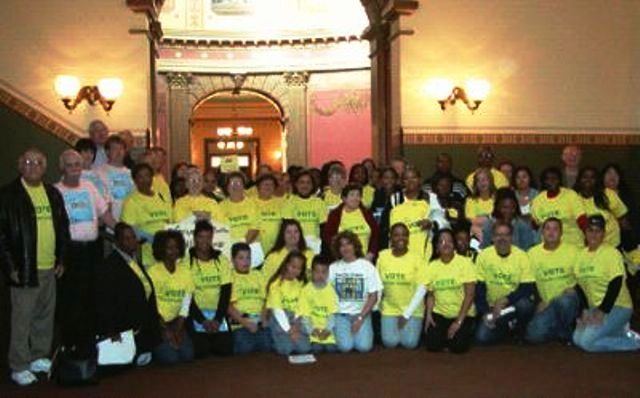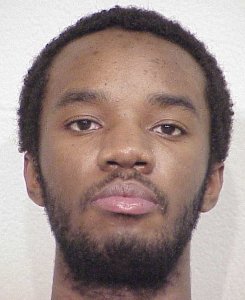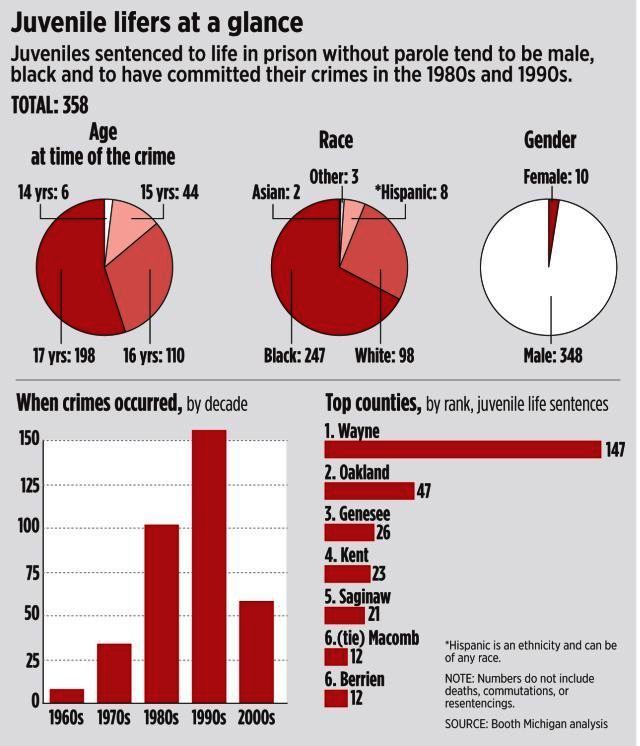
Michigan families traveled from across the state in 2006 to support legislation that would have outlawed juvenile life without parole sentencing' they included families of prisoners as well as family members of victims. Photo: Diane Bukowski
VOD ed: Juvenile lifer Edward Sanders alerted us to this series of articles being published around the state by six different newspapers. Hopefully this coverage will encourage progress in the federal lawsuit being heard by U.S. District Court Judge John Corbett O’Meara, brought by the American Civil Liberties Union on behalf of nine juvenile lifers. The last action on the case was Aug. 5, when the ACLU filed a response to the state’s motion for a stay pending interlocutroy appeal. Write Edward Sanders, #141545 at Kinross Correctional Facility, 16770 S. Watertower Drive Kincheloe, MI 49788.
November 06, 2011; Updated: Thursday, November 10, 2011
By John Barnes Mlive.com
They were teenagers once, and did horrible things, or were in horrible places. People died. Sometimes at their hands; sometimes not. But they were present.
And for that, they were told they will die, too, in prison.
These are Michigan’s “juvenile lifers,” although most are much older now, sentenced to life in prison without chance of parole. And there are more in this state than in almost any other.
There is Keith Maxey, wounded in a drug theft gone bad. He was unarmed and fled, but another man was killed. A jury found the 16-year-old just as responsible as if he had pulled the trigger. Except the shooter got a lighter sentence.
There, too, are identical twins David and Michael Samel, arrested at 17 for beating a pool hall worker to death. Michael pleaded to a reduced charge and was released in 2009. David took his chances with a jury. He is in the 30th year of life without parole.
And there is Cedric King, 14 when he helped set up a marijuana thief to be killed. Except the court thought he was a year older, and the victim survived. Still, confusion has persisted for years over whether he was given the state’s severest punishment, or something less, a Booth Michigan investigation found.
As a federal judge in Detroit weighs whether such sentences are unconstitutional, reporters from six newspapers and MLive.com spread out across the state.
FACTS
A juvenile lifer primer
In general, mandatory life without parole is reserved for first-degree murder, but that covers a range of crimes: premeditated killing; intentional or unintentional death during another felony; or aiding and abetting the previous crimes.
Here’s how the treatment of minors charged and convicted of such crimes has evolved:
- Pre-1988: Only 17-years-olds automatically treated as adults; 15- and 16-year-olds waived to adult court only if juvenile judge approved. No one younger than 15 tried in adult court.
- October 1988 through 1996: 15- and 16-year-olds automatically waived to adult court. A judge had two options: Mandatory life in adult prison, or send them to a juvenile facility for release no later than 21. The number of juvenile lifers more than doubled from the previous eight years.
- 1997 to now: 14-year-olds also automatically tried as adults. Prosecutors also can designate 14- to 16-year-olds for “adult-like” proceedings in juvenile court, and request those 13 and younger be subject to the same proceedings.The change gave juvenile judges three options:
- Commit the minor to a juvenile facility until 21.
- Sentence them as adults to life without parole.
- Apply a “blended” sentence, where the minor would go to a juvenile facility until 21. The judge would then determine whether to order mandatory life.
Nathaniel Abraham is the most famous case. He was 11 in 1997 when he killed 18-year-old Ronnie Green. He was charged with first-degree murder but convicted of second-degree murder. A juvenile judge chose to sentence him to a juvenile facility. Abraham was released in 2007 at 21, but was arrested 16 months later on a drug charge. His earliest release date is next August.
They interviewed nearly two dozen inmates, including some who committed their crimes before they could drive. They also talked to victims’ families, prosecutors, judges and lawmakers.
What they found was regret and bitterness, anger and forgiveness. They also found an issue measured more in shades of gray than black and white.
Ask Shirley Schwartz what her brother would think of imprisoning juveniles for life, and she pauses.
“That’s a really difficult question,” she finally says. Her college professor brother was “very liberal,” she recalls, an advocate for his urban neighborhood in Grand Rapids’ Heritage Hill. That was where he met his killers; Jerry Freid died after being beaten to death with a baseball bat during a burglary by a 16- and a 17-year-old.
Ask Schwartz the same question, what she thinks of life sentences for juveniles, and she does not hesitate.
“I never believed in the death penalty,” she says. “After this happened, I was pretty sure I could pull the switch. You can afford to be a liberal when it doesn’t touch you.”
Told one of her brother’s killers died in prison, Schwartz says one word.
“Good.”
Michigan spends more than $10 million a year to house more juvenile lifers than all but one other state, Pennsylvania.
In all, 358 inmates are serving life sentences for crimes committed from ages 14 to 17. One in five has been in prison 25 years or longer.
TERMS
Time and the crime
The law has long recognized lesser culpability in death cases, allowing sentences short of mandatory life. The main types:
- FIRST-DEGREE MURDER
Penalty: Mandatory life without parole
Involves: Pre-meditated intent; participation in a felony where someone dies, whether or not intentional; assisting in such crimes.
Example: A serial killer; a robber who shoots a store clerk during a scuffle; a getaway driver.
Prisoners: 3,384 serving mandatory life; one in 10 for crimes committed at ages 14 to 17.
- SECOND-DEGREE MURDER
Penalty: Any number of years up to life, parole possible
Involves: Knowingly creating a high risk of death or great bodily harm.
Example: Neighbors argue, one gets a gun, has time to reconsider, but shoots the other; also a common plea-bargain from first-degree murder.
Prisoners: 3,728, nearly 60 percent with 25-year minimums or less. About one in five received a parolable life term.
- MANSLAUGHTER
Penalty: Maximum 15-year sentence
Involves: A heat-of-the-moment killing; gross negligence or an assault leading to unintentional death.
Example: One spouse shoots another upon discovering their partner cheating in their home; a fight where a person trips and hits their head.
Prisoners: 448; one in three received minimums of five years or less.
- NEGLIGENT HOMICIDE
Penalty: Maximum two-year sentence
Involves: Ordinary negligence
Examples: A driver reaches to retrieve something and causes a fatal crash. Some prosecutors are reluctant to bring the charge.
Prisoners: Most go to county jails; just six in prison.
All this could change. A federal lawsuit pending in Detroit claims life without parole for juveniles 17 and younger constitutes cruel and unusual punishment. It seeks mandatory parole reviews when young inmates reach 21, then every five years after. (Click on http://voiceofdetroit.net/2011/09/06/battle-for-juvenile-lifers-picks-up-steam-in-michigan-california/ for more details; also see further links at end of story.)
The lawsuit has had early success. A judge in July threw out the claims of eight inmates imprisoned since their teens, ruling too much time had passed. But he allowed one inmate to move forward — Keith Maxey.
Deborah LaBelle, the lawsuit’s lead attorney, says she has met with about 100 of the inmates and corresponded with more than 300. She blames a “toxic combination” in Michigan of juvenile reforms, mandatory sentences and immature judgment she says puts minors at a disadvantage in adult courts.
“I see so many repetitive patterns that I find very painful, where someone is with an adult and the adult does the shooting and is clearly in control of this kid, and the adult manages to negotiate a fairly good plea deal,” said LaBelle, who represents the American Civil Liberties Union.
“Some are out now. And the juvenile who said, ‘I did something, but I didn’t hurt anybody myself,’ will now serve until they die.”
Not so simple?
There are worse examples. Kent County Prosecutor Bill Forsyth quickly rattles off case after violent case:
- The 16-year-old who suffocated and beheaded another teen, then videotaped his mutilation of the victim.
- The 16- and 17-year-old who flagged down a pregnant motorist. One shot the 22-year-old as she knelt in a deserted rail yard after agreeing to drive them to a gas station.
- The 16-year-old who shot a taxi driver in the head at point-blank range during a holdup.
His office helped convict all but four of Kent’s 23 juvenile lifers.
“To say all 14-year-olds are incapable of committing heinous crimes is simply not the case,” said Forsyth, who rejects the notion that life without parole should never be an option for minors.
But, he added, “I think you have to be really careful as a prosecutor whether you go that route or not.”
Once, 17-year-olds were the only minors automatically tried as adults. All others stayed in juvenile court with its lesser penalties.
That changed in 1988, when rising violence led to get-tough reforms.
Teens as young as 15 and 16 were now tried automatically as adults for serious crimes. For those convicted of first-degree murder, or participating in a crime where someone was killed, judges had just two options.
They could sentence the youth to a juvenile facility, where they would be released no later than 21, or to mandatory life in an adult prison. Many chose the latter, sometimes painfully.
That was the case with Michael Perry, who was 16 when he fire-bombed a Saginaw home, killing three children. Judge Leopold Borrello lamented his limited choices – a juvenile sentence that would release Perry too soon, and one he believed would keep him too long.
“The only conclusion I can reach is that the law deprives me of doing justice in this case,” Borrello said, adding he hoped a governor in 20 years would seriously consider a commutation or pardon.
That was 20 years ago this past summer. Perry, now 38, is in the Saginaw Correctional Facility.
In 1997, the law was toughened again. Fourteen-year-olds were added to those tried in adult court, and judges there could no longer choose juvenile sentencing. In addition, juvenile judges were given the option of imposing adult sanctions on those even younger than 14.
“It doesn’t matter so much whether it’s 12 or 14 or 50 or 60,” said former state Sen. William VanRegenmorter, who chaired the Senate Judiciary Committee and helped craft the law. “The juvenile justice reform act’s basic finding was that if you do the crime you do the time.”
The number of juvenile lifers exploded. In the 23 years since the first reforms went into effect in 1988, 116 juveniles ages 14 to 16 have been sentenced to life in adult prison.
In the same period before that, when it was tougher to send juveniles younger than 17 to adult court, there were 46 cases.
BY THE NUMBERS
- 3,384: Prisoners serving mandatory life
- 1: in 10 who were 14 to 17 at the time of their crime
- 358: “Juvenile” inmates serving life without parole
- 69: Percent who are black
- 76: Number who have served 25 years or longer since sentencing
- 31: Percent of juvenile lifers who did not commit the actual homicide
- 67: Oldest living juvenile lifer in the state
- 49: Years he has been behind bars
- 23: Kent County juvenile lifers
- 1: Ottawa County juvenile lifer
- 12: Juvenile lifers from Macomb County, the state’s third-largest county
- 12: Juvenile lifers from Berrien County, which has 680,000 fewer people than Macomb
- 12: Consecutive years from 1987-98 of double-digit homicide cases involving juveniles
- 198: Juveniles sentenced to mandatory life for those crimes
What the numbers show
Juvenile lifers look a lot alike. They are almost exclusively male. Two out of three are black. Most were 17 at the time, but 45 percent were 16 and younger. Nearly half did their crimes in the 1990s.
Wayne County has sentenced the most, 41 percent. Number-two Oakland County is well back, at 13 percent, followed by Genesee, Kent, and Saginaw counties with about half as many as Oakland.
The racial inequity is just one area that troubles reformers. Researchers are also finding adolescents have a less developed maturity and sense of responsibility compared to adults.
That was among the conclusions the U.S. Supreme Court arrived at in two decisions. The first, in 2005, said juveniles 17 and younger could not be sentenced to death. The second, in 2010, moved the line further. The court said they could not be sentenced to life without parole in non-homicide cases.
Writing for the majorities, Justice Anthony Kennedy noted the “special difficulties encountered by counsel in juvenile representation, given juveniles’ impulsiveness, difficulty thinking in terms of long-term benefits, and reluctance to trust adults.”
It is that immature development that puts many juveniles away for life, critics say. More than one-third in Michigan rejected plea bargains that would have allowed eventual release, according to evidence submitted in support of the federal lawsuit.
Sometimes that’s due to misguided allegiance to others with more direct involvement in killings, said LaBelle, the ACLU lawyer. Sometimes they can’t imagine accepting a deal that would put them away until their 30s and 40s, so they take a chance with juries, she added.
Many did not commit the actual homicide. Instead, about one in three were convicted of either aiding and abetting the crime or of being involved in other wrongdoing when it occurred, LaBelle said.
In Michigan, the mandatory penalty is the same, life without parole.
“The most sympathetic 15-year-old accomplice to a felony-murder and the most sociopathic adult serial killer will receive the same sentence, without any judicial ability to take stock of the difference between the two for sentencing purposes,” University of Michigan Law School professor Kimberly Thomas wrote in a February article in the Michigan Bar Journal.
The victims’ perspective
Shirley Schwartz, whose brother was beaten to death with a baseball bat, counts her family among the victims of sociopaths, although they weren’t adults.
The teen attackers also were convicted in a series of rapes and robberies in Grand Rapids’ historic Heritage Hill neighborhood starting in 1977, the year Jerry Freid was killed.
Thirty-four years have passed, equal to her brother’s lifetime. But the memories pour forth.
How she was nearly hospitalized from weight loss. How his ex-wife told their two daughters he died in an accident, only to have the children learn the truth at school. How her mother suffered until her death.
She cries briefly.
She did not know one of the attackers died in prison in 2006. She did not know the life sentence for the other was dismissed, his conviction overturned due to an inadmissible confession.
She did not know he was freed after serving less than 19 years for the rapes and robberies.
Now 51, the former juvenile lifer has had no run-ins with the law in the 13 years since, police records show. He holds a job in Kentwood, and complies with the sex-offender registry.
Schwartz, 65, hopes he was able to turn himself around in prison. But she stops there.
“I don’t have to forgive those guys for what they did. I don’t have to turn the other cheek. They took a life,” she says.
“I think the difficult part is that if you change the law, some bad people with good attorneys will use it to their favor.”
E-mail John Barnes: jbarnes@grpress.com‘
VOD Ed.: Voice of Detroit has published numerous articles on the issue of juvenile lifers. In addition to the VOD link included above, click on the following links to read more detailed analyses:
http://voiceofdetroit.net/2011/03/06/voice-of-juvenile-defendants/
http://voiceofdetroit.net/2011/01/15/free-davontae-sanford/
VOD editor Diane Bukowski also wrote dozens of articles on the issue for The Michigan Citizen prior to her forced departure from the paper in 2010 after 10 years. Among them since 2006:
http://michigancitizen.com/the-schooltoprison-pipeline-p7528-1.htm
http://michigancitizen.com/worthy-opposes-bills-to-parole-juvenile-lifers-p7406-1.htm
http://michigancitizen.com/lawmakers-consider-ban-on-life-for-juveniles-p7378-1.htm
http://michigancitizen.com/juvenile-lifer-bills-in-senate-p7116-1.htm
http://michigancitizen.com/new-legislature-second-chance-for-prisoners-p4013-1.htm
http://michigancitizen.com/families-plead-give-imprisoned-juveniles-second-chance-p3593-1.htm
http://michigancitizen.com/un-condemns-juvenile-life-without-parole-sentences-p3373-1.htm
http://michigancitizen.com/council-members-support-second-chance-for-juvenile-lifers-p2801-1.htm
http://michigancitizen.com/second-chance-for-juvenile-offenders-p2528-1.htm
VOD readers have sent links to the following websites dealing with juvenile lifers:









